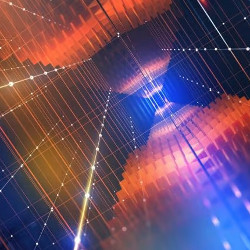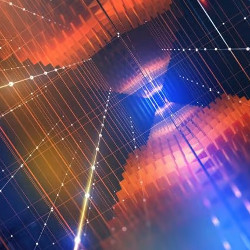
Quantum computing is drawing enormous interest—and funding—although widespread application is probably years in the future. Researchers have demonstrated the “quantum advantage” (originally called “quantum supremacy”) of many orders of magnitude in speed over classical (non-quantum) computers on targeted algorithms. They are also searching for ways to exploit current smallish, error-prone quantum devices.
General use, however, is expected to need quantum error correction (QEC), which will require much larger systems than are now available. Nonetheless, over the past 20 years, the ideas that make QEC possible already have influenced physicists’ understanding of the universe.
In particular, error-correcting codes describe aspects of black holes, superdense astronomical objects where quantum mechanics and general relativity conflict. “Ideas that were invented to protect quantum computers from data corruption turn out to be very relevant to understanding the structure of spacetime,” said Patrick Hayden, a professor of physics at Stanford University.
These ideas also have helped resolve a paradox about information that objects carry into black holes. Understanding quantum information could even clarify how our perceived three-dimensional reality actually emerges from an underlying quantum world.
These contributions of quantum computing to physics did not require practical machines. However, as the technology improves, it also may directly advance the theoretical simulation of black holes and spacetime.
Quantum Information
Qubits, the quantum bits envisioned for computing, are not limited to 0 or 1 like classical bits. Instead, they are prepared in a “superposition” of the two values, weighted by complex numbers whose amplitudes determine the probability these values are ultimately measured. Before that, the phases of these complex weights can interfere constructively or destructively during operations that blend different qubits.
Algorithms for quantum computing, first devised in the 1990s, exploit this interference to selectively enhance the probability that the qubits represent a target answer when they are measured later. A major engineering challenge is “decoherence” of qubits due to interactions with their noisy environment, effectively measuring them before the operations are complete.
Quantum error-correcting codes, also invented in the 1990s, avoid this problem by spreading the information among many “physical” qubits. These schemes provide a degree of redundancy so that a modest number of errors do not alter the distributed “logical” qubit. Unfortunately, the number of physical qubits required—for current error rates, as much as 1,000 times the number of logical qubits—is well beyond the scope of current hardware.
The key ingredient is “entanglement,” in which the quantum states of two or more qubits are intertwined. Quantum mechanics predicts their measured values will be tightly correlated even though, individually, they are only knowable probabilistically. Experiments have repeatedly confirmed this surprising phenomenon.
A Holographic Universe
The connection to quantum gravity arises from a long-standing suggestion that the universe is “holographic,” like a flat hologram that generates a three-dimensional image. In this view, although the boundary of the universe has one fewer dimensions, it contains all the information to describe its bulk.
This idea was made more concrete by Juan Maldacena, now at the Institute for Advanced Study in Princeton, NJ, who in 1997 conjectured a correspondence between very different types of theory. On one side, denoted AdS for “Anti de Sitter,” are gravitational theories in a spacetime whose curvature gives it a well-defined boundary. In the actual universe, we observe accelerating expansion that implies the opposite curvature of a “de Sitter” universe. “The gravity theories are not identical to the gravity theory that describes our own world, but it can be similar,” Maldacena said, and the work is widely used.
On the other side are conformal field theories, or CFTs, which feature strong quantum mechanical interactions between particles, but no gravity. They can be thought of as living on the surface of the gravitational universe. The two theories are “dual” to each other, so researchers can solve whichever is more convenient and translate to the other.
Error-Correcting Spacetime
The correspondence has been used to study both gravity and quantum systems. In 2015, a group of researchers discovered that even if a large chunk of the quantum surface is unknown, the remainder still completely determines the gravitational bulk, just as error-correcting codes would allow a quantum computer to withstand disruption of some of the qubits. The AdS/CFT codes are surprisingly efficient at encoding information, although putting them to use may not be so easy.
One profound vision still being explored is that spacetime actually “emerges” from an interconnected quantum reality.
In some ways, this result is not surprising, at least in retrospect, Hayden said, because quantum mechanics is reversible, and thus information must be preserved somewhere. Indeed, researchers have found that error-correcting codes are a ubiquitous feature of chaotic, highly-interacting quantum systems. “It’s something that can happen very naturally,” Hayden said, “without someone having to actively sit down and design a code.”
These developments also clarify an old paradox. Physicists once thought that when something fell into a black hole, all information about it would be lost in the inaccessible interior. Stephen Hawking, however, showed that black holes slowly evaporate by emitting radiation, so there would eventually be no place for the information to hide.
Researchers long suspected that the information is somehow carried away in the emitted radiation, by virtue of its entanglement. In the past few years, the improved understanding of quantum information finally allowed researchers to precisely quantify the entropy of the Hawking radiation. “The new formula knows about the interior of the black hole, so it depends on the geometry of the interior,” said Maldacena.
Many of the advances in the past seven years have had funding from the Simons Foundation’s “It from Qubit” collaboration. Hayden, the director of the project, said it is coming to an end—by design—but it has made the once “fringy” field respectable. Still, he noted, “More traditional ways of approaching questions in quantum gravity are extremely important and need to be funded properly.”
One profound vision still being explored is that spacetime actually “emerges” from an interconnected quantum reality. “What we’ve learned is that the structure of spacetime is much more subtle, and in some circumstances you can say ‘nonlocal,’ than our intuition suggests that it should be,” Hayden said. “The story seems to be that entanglement stitches space together. It really is the stuff that holds space together.”
Quantum Simulations
A thought-provoking illustration of nonlocal entanglement is “teleportation” of the quantum state of a particle through a wormhole that connects distant points in space. Experimental teleportation of quantum states via entanglement has been repeatedly confirmed, but of course wormholes are not readily available. In 2019, however, a group of researchers proposed using AdS/CFT to emulate a traversable wormhole in the lab using a handful of trapped ions or atoms, which are candidates for implementing qubits.
Maldacena expects that “If you really want to check a prediction from gravity, we might be talking about 1,000 to perhaps 10,000 qubits.”
The qubit passes through a scrambled state that is completely mixed up with other degrees of freedom, but when it reappears at the other side of the wormhole, it surprisingly “recoheres,” said Adam R. Brown, a research scientist for Google in Mountain View, CA. The proposed experiment would give a clear physical picture of this process, he said, and results are beginning to appear as this story goes to press.
For small experiments with a few dozen qubits, however, “You’re not really learning anything about quantum gravity … because you could more easily discover the answer just by running a classical computer,” Brown cautioned. “You’re only going to learn something new from your quantum computer if you’re in what’s called the ‘quantum advantage regime,'” and not just for the algorithms chosen for demonstrations on current systems.
Maldacena expects that “If you want to really check a prediction from gravity, we might be talking about 1,000 to perhaps 10,000 qubits.” Similarly, simulating the properties of quantum materials or quantum chemistry—the sort of challenge that led theoretical physicist Richard Feynman to propose quantum computing—require a much larger scale than is yet available.
Nonetheless, researchers already are exploring ways to leverage quantum computing in the current noisy, intermediate-scale quantum (NISQ) era. For example, Enrico Rinaldi, a visiting scientist at RIKEN near Tokyo, and others have been emulating matrix-quantum-mechanics models that would give detailed insight, through AdS/CFT, into black holes.
In particular, Rinaldi has explored the Variational-Quantum-Eigensolver (VQE) method developed by his co-author and group leader Franco Nori (who is at RIKEN and the University of Michigan) and others. “VQE is one of the most successful quantum/classical hybrid algorithms that scientists and engineers are using on current quantum hardware,” Rinaldi said. This algorithm separates the calculation into two parts. Given a set of parameters, the quantum part finds the lowest-energy quantum state, despite some errors. In an outer loop, the classical part varies the parameters to search for the optimum. “Typically, the classical part is the most computationally demanding,” he said.
This early exploration simulated the quantum machine classically. “To find a path forward on quantum devices, we need to study this type of scaling and the type of errors that we are sure to encounter,” Rinaldi said. The team also compared the results with a deep learning approach to the same problem. Classical artificial intelligence is “definitely more mature and it scales better,” Rinaldi said.
Although the potential impact of quantum computing for these calculations is still being assessed, the concepts of quantum information will surely have lasting impact.
Monroe, D.
Surprise Comes Out of Black-Hole Studies: Error-Correcting Codes, Communications, October 2016, bit.ly/3PZvsMC
Wolchover, N.
How Space and Time Could Be a Quantum Error-Correcting Code, Quanta, January 2019, bit.ly/3zyVekW
Ball, P.
Wormholes Reveal a Way to Manipulate Black Hole Information in the Lab, Quanta, February 2020, https://bit.ly/3OvBpiQ
Miller, K.
It from Qubit and the Gravity of a Quantum Universe, Simons Foundation, March 2022, https://bit.ly/3vl4QgL





Join the Discussion (0)
Become a Member or Sign In to Post a Comment